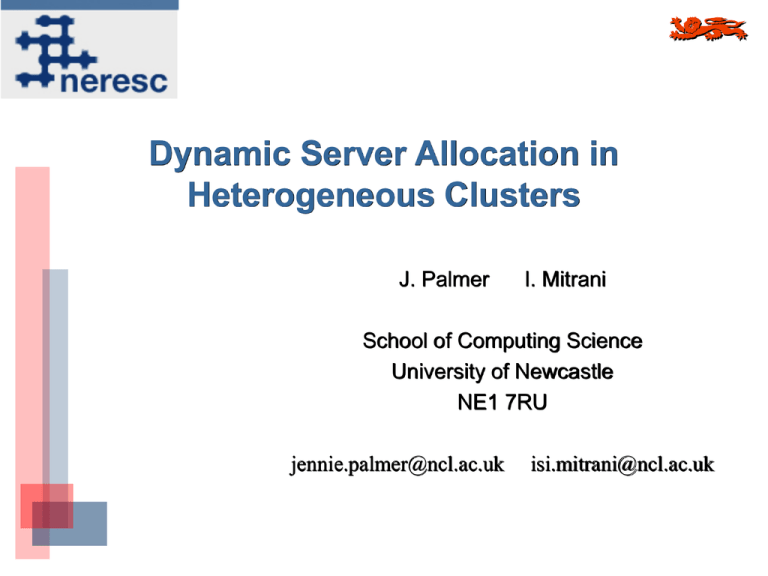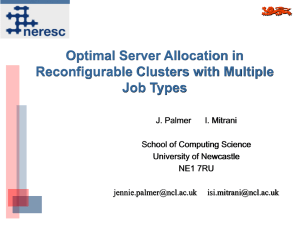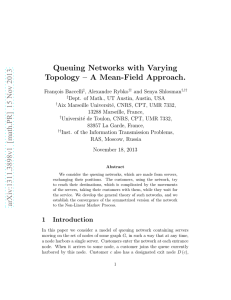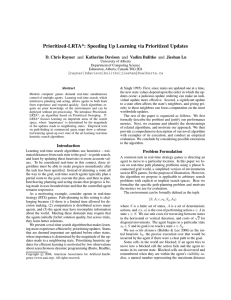Dynamic Server Allocation in Heterogeneous Clusters
advertisement

Dynamic Server Allocation in Heterogeneous Clusters J. Palmer I. Mitrani School of Computing Science University of Newcastle NE1 7RU jennie.palmer@ncl.ac.uk isi.mitrani@ncl.ac.uk Outline Introduction The model Computation of the optimal policy Experimental Results Conclusions 2 Introduction In a Grid environment, Users submit jobs without heterogeneous clusters of necessarily knowing or servers provide a variety of caring where they will be services to widely distributed executed user communities Pool Manager Job Requests Users 3 The model - 1 Demands (jobs) of two types are submitted to a pool of N servers A configuration consists of dedicating k of the servers to type 1 and N-k to type 2 N Servers l1 b1 type 1 k queue 1 l2 b2 type 2 queue 2 N-k 4 The model - 2 Servers can be switched from type 1 to type 2 and vice versa What is a good policy for deciding dynamically when to reconfigure the system? N Servers l1 Switch a server b1 type 1 k queue 1 type 2 l2 b2 queue 2 N-k 5 The model - 3 Arrival rates l1 and l2 l1 Average service times b1 and b2 l2 b1 b2 Holding Costs (the cost of waiting) c1 and c2 Switching Costs C1,2 and C2,1 h z Switching Rates z and h 6 System State The system state is S ( j1 , j2 , k1 , m1, 2 , m2,1 ) The system has been modelled by a continuous Markov process A dynamic configuration policy must decide, for any given state S, whether to i. Do nothing ii. Initiate a switch from queue 1 to queue 2 iii. Initiate a switch from queue 2 to queue 1 7 Computation of the optimal policy The optimal policy is specified by the action d which minimises the right-hand side Principles of dynamic programming have been used to solve the finitehorizon optimization problem Vn ( S ) j1c1 j2 c2 min c(d ) qd ( s, s ' )Vn 1 ( S ' ) d S' The computational complexity of determining the optimal switching policy is of the order 2 3 O ( J N n) 8 Experimental Results Optimal decisions have been stored in look-up tables which may then be referred to during simulations j2 0 1 2 3 4 5 6 7 8 9 10 0 1 2 3 j1 4 5 6 Key 7 Do nothing Switch 1 2 8 Switch 2 1 9 10 9 Heuristic Policies An exact characterisation of the optimal policy is unlikely Instead, formulate a heuristic which performs reasonably well and is easy to implement Three policies compared in simulations i. Static Do no switching at all ii. Heuristic Attempts to balance the total holding costs of the two job types. E.g. switch from queue 1 to queue 2 if: iii. Optimal Use pre-computed tables of optimal decisions 10 Increasing number of servers 11 Increasing loads 12 Conclusions A problem of interest in the area of distributed computing and dynamic Grid provision has been examined The optimal reconfiguration policy can be computed and tabulated For practical purposes, an easily implementable heuristic policy is available A natural generalization of this problem would be to consider more than two job types and clusters 13 Acknowledgment This work was carried out as part of the collaborative project GridSHED funded by North-East Regional e-Science Centre and BT This project also aims to develop Grid middleware to demonstrate the legitimacy of our models, providing a basis for the development of commercially viable Grid hosting environments Project web page: http://www.neresc.ac.uk/projects/GridSHED/ 14






